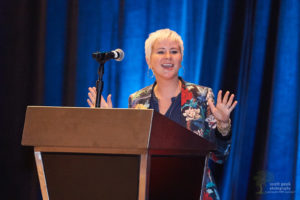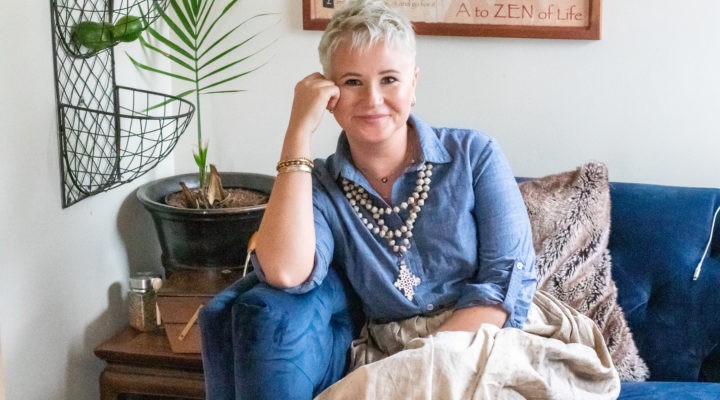Christen Green Kinard says she has no formal religious education, but as the child of career missionaries, she knows the right things to educate churches about their online ministry during the pandemic.

Christen Green Kinard (Photo/Scott Peek)
Kinard is a communications professional and daughter of Butch and Nell Green, field personnel with the Cooperative Baptist Fellowship. Now based in the Washington, D.C.-area, she is helping churches through Digital Congregations, a communications firm that caters to communities of faith.
The business-as-ministry approach is nothing new to Green Kinard, since she and her mother co-founded Threads by Nomad in 2016. Before COVID-19, the Houston-based ministry employed refugees to manufacture garments for a clothing line operated by the duo. That ministry switched to making masks in March.
Now, CBF North Carolina, CBF Texas and other state groups have tapped Green Kinard to lead workshops to help congregations maximize livestreaming and social media practices during the coronavirus outbreak. A social media deep dive course is being offered later in the month.
“Churches are realizing the pandemic has changed the way they are going to communicate in the future, and even post-pandemic,” she said.
She spoke with Baptist News Global about some of those communication challenges and about her parents’ influence on her work.
What is your communications background?
I started in communications 10 years ago, and I have done everything from operating a small marketing firm that catered to small businesses and other organizations all the way to being the communications director for an independent school in the D.C. area.
What gave you the idea to start this new business?
It was like I was watching a movie during the pandemic. I could see all these churches scrambling and trying to figure out what to do. They were doing the best they could. All of us have been scrambling. But over the weeks, I heard this recurring voice in the back of my head saying, “You could help. You could help.” I did a good job of ignoring that voice until it became more evident how I could serve.
Do you consider this endeavor to be part of a calling?
Yes. As I said, I did a very good job of ignoring God’s voice for a while. But God wanted me to change some things — wanted me to change jobs in the middle of a pandemic, and I was not thrilled with that. But I realized that if I listened, I could have this unconventional ministry. I understand the communications world, and I also understand the church world because I grew up in it. Now I see that as an MK (missionary kid), churches took care of me when I was growing up. Now I can say thank you by helping churches.
Your parents are known for blending business and ministry as field personnel. How did that approach impact you?
I recognize that it is typical of a child to be unwilling to recognize what she may have learned from her parents. Nonetheless, in some ways I believe it was my own insistence that business can be a ministry that inspired my parents in their work — you’ll have to ask them if they agree. We have long had conversations as a family about how ministry can look different — and why it must look different — from what it has been in the past. This redefining and reshaping of ministry over the years is a journey we’ve traveled together. It has enabled my parents, me and my brother to utilize all of our God-given talents, skills and experience in service of others. It has enabled us to create new boxes instead of trying to fit into old ones.
How are you defining “communications” in the context of your workshops?
This is a crash course in communications for churches specifically designed for pandemic times. We are talking about livestreaming and social media practices that promote community building, online giving and maximizing church websites to build understanding and audience.
What are the primary ways the pandemic has disrupted church communications?
First and foremost, the Sunday morning service is where it has upended everything. Most churches I am connected to have not returned to in-person worship unless they are meeting outdoors. Many have gone online as a result, but it’s been about much more than finding digital alternatives. They have tried to foster that feeling of connection, that ability to be church in a virtual space. For a lot of churches, that looks like livestreaming that encourages watchers to participate.
Before the pandemic, a lot of churches were using grassroots communication methods like bulletin boards, flyers and making announcements in Sunday school classes. Obviously, the pandemic just took away the typical forms of communication. This is where I see a lot of churches reaching out on social media. It’s not just to share information, but to engage in storytelling. Overall, what I am seeing in all of this is churches setting themselves up to be more effective servants of people.
How does a church know if it has an effective communications strategy?
The first step is to sit down and write out the mission of your church. Then you note who your congregation is and whose needs you are trying to meet and what those needs are. Then you look at your bulletins, your email newsletter, your livestreaming, your social media. And you ask yourself: do each of these align with our mission? Do they meet the needs of our congregation? You walk through that exercise and see what is working and what you need to lean into. You also look at where you need to make tweaks, and then you identify those places where you can let go and move on to something else. Some churches are unwilling to experiment with communications, but in a pandemic there is an incentive to try things knowing you won’t have to do them forever. That’s how we become better communicators.
Why is social media so important in all of this?
Social media has the power to build community in a digital space. The platform has the power to help us be church, digitally. It’s not that it replaces one-on-one, but it can be a really important component, especially when we don’t have the ability to gather in person. It’s important to tell who we are as churches and to invite our members to participate in telling our stories.
Related articles:


